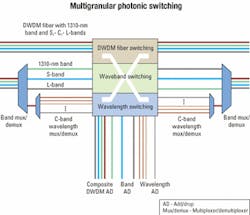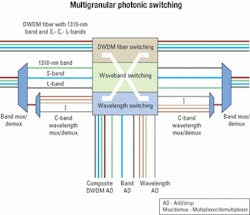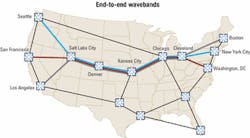Multigranular photonic switching in all-optical networks
Along with its many benefits, multigranular networking can reap significant cost savings for the next several years.
RAO LINGAMPALLI, Calient Networks
The advent of photonic networking will change the way optical transport networks are built and operated. In the past few years, DWDM transmission technology solved the capacity challenges faced by many carriers. It continues to advance with higher channel counts and extended distances between regeneration. Carriers are pushing the envelope of DWDM transmission technology and driving down the cost per bit with terabits of capacity per fiber.
But while carriers have solved the capacity side of the equation by meeting demand with DWDM, the rapid scaling of DWDM in optical networks has exponentially increased the number of wavelengths and created another challenge: bandwidth management. In addition, increasing channel bit rates from OC-192 (10 Gbits/sec) to OC-768 (40 Gbits/sec) will create electronic-switching bottlenecks in transport networks. Carriers now need to effectively manage this explosive growth in transport capacity.
The rapid growth of capacity has created the need for optical bandwidth management of thousands of wavelengths at network junctions. Each wavelength in the composite DWDM signal needs to be demultiplexed and switched electrically with opaque optical switches, which create electronic bottlenecks at these nodes due to the inherent bit-rate-dependent switching. All-optical (photonic)-switching systems can effectively solve optical bandwidth management.
In the past two decades, carriers have deployed hierarchical digital crossconnect (DXC) systems to groom voice trunk groups between voice switches and low-speed private-line services from DS-0 (64 kbits/sec) to DS-3 (45 Mbits/sec). Narrowband and wideband DXCs are the typical interfacing grooming and aggregation platforms on the transmission side of the network. Traffic groomed to STS-1s (52 Mbits/sec) from wideband DXCs is aggregated into OC-3 (155 Mbits/sec)/OC-12 (622 Mbits/sec) by broadband DXCs.Instead of centralized grooming and aggregation functions performed with these multiple hierarchical DXCs, it was more efficient to have a single DXC system combining more than one level of grooming. This evolution in metro grooming platforms over the past few years was in more distributed systems pushed toward the edge of the network.
From the DXC network experience, it is evident that multiplexing lower-speed channels to high-speed trunks in the core facilitates ease of management. The same principle can now be applied to manage all-optical traffic at different granularities. Since electrical or subwavelength grooming and aggregation functions are moving toward the edge of the network, carriers require photonic-switching systems with multigranular switching at wavelength, band, or sub-band-and full-spectrum DWDM fiber levels with a single-stage switching fabric.
Traffic behavior
There is also a change in traffic behavior in carrier networks. In voice-centric networks, traffic terminates with an average distance of 600 km. However, as networks become more data-centric with IP services, the average termination distance has increased three times to about 1,800 km for IP traffic in large Internet service-provider backbone networks. This trend translates to more transit traffic at intermediate nodes. Transit traffic is best handled in the photonic domain.
Deployment of OC-768 technology in core transports is expected to occur slowly in the near future. As a result, carriers will deploy an increased number of wavelengths of mature OC-192 technology in core networks. In deploying a greater number of wavelengths that will scale with rapidly growing IP services, the need for multigranular switching will be greater than ever before. Multigranular wavelength switching is the main characteristic of photonic-switching systems with:
- Concurrent all-optical switching and routing of individual wavelengths, wavebands, and composite DWDM signals on a fiber-or a combination of these.
- Wavelength transparency between 1260 and 1625 nm.
- Intelligent optical-network routing and management, based on standard Generalized MPLS (GMPLS) network protocols that perform efficient grouping and grooming of wavelengths and bands at network switching nodes.
The transparency of photonic crossconnects allows the service layer to scale switching independent of the core transport. Entire groups or bands of signals can be terminated on compliant client systems such as terabit routers, data switches, optical-electrical-optical (OEO) subwavelength grooming (STS-1) switches, and metro/regional DWDM platforms.
What's up with wavebands?
Similar to the bands in radio and the microwave portion of the electromagnetic spectrum, bands can be defined and standardized in the transmission part of the spectrum in optical fibers. The optical transmission spectrum consists of 850-nm (only in early fibers), 1300-nm, and 1550-nm windows -synchronizing with low-loss valleys in the optical transmission spectrum.
A waveband may consist of multiple groups or sub-bands of wavelengths. For example, a band may comprise four groups with guard bands between the groups to reduce crosstalk between groups. Carriers begin deployment with a group in the chosen band, then upgrade the capacity of the DWDM by adding more groups and populating transponders at the terminal points.
The first waveband standardized by the International Telecommunication Union (ITU) in the 1550-nm window is the C-band (more commonly known as ITU grid). To form bands, groups of wavelengths are formed into a band such as the C-band between 1530 and 1565 nm. Depending on channel spacing, the number of wavelength channels can be defined inside a band. If consecutive wavelengths have 50-GHz spacing in the C-band, for example, there will be 64 wavelengths. The wavelengths can be organized into four groups of 16 wavelengths, with guard bands between them. Other bands include the S-band (~1480-1520 nm), the L-band (~1580-1625 nm), and a future S-band (~1300 nm).
Challenge is implementationPhotonic-switching systems with a single switching stage are ideal for multigranular optical signal switching. Full-spectrum DWDM fibers, wavebands, and individual wavelengths from modularly designed DWDM systems can be passively switched using the same switching fabric (see Figure 1). Implementation at a typical node is shown with open architecture, in which photonic-switching systems will interoperate with any properly designed DWDM system, facilitating best-of-breed technology choices. That is the best implementation choice at the current time, given the channel spacing and number of wavelengths per band and because some bands are not standardized in international standards bodies.Figure 2. End-to-end grouped wavebands S, C, and L from source nodes Seattle, San Francisco, and Los Angeles to destination nodes New York City, Washington, DC, and Boston, respectively, can be grouped at the Salt Lake City network junction and de-grouped at the Cleveland network junction with intelligent waveband switching enabled by Generalized MPLS signaling. The wavebands are multiplexed and transmitted on the same fiber on the common subpath between Salt Lake City and Cleveland. Full-spectrum fiber switching is performed at the Denver, Kansas City, and Chicago nodes.
There are two ways of grouping multigranular optical signals: end-to-end traffic grouping and intermediate (transit) traffic grouping. In end-to-end grouping, traffic between the same source and destination pairs can be grouped at the end-terminal nodes into groups or bands with multigranular photonic switches, instead of routing these signals through the network at wavelength level. Intermediate grouping at network junctions can further aggregate these groups of wavelengths or bands from different source destination pairs into higher-level bands or full-spectrum fibers on a common subpath (see Figure 2).
GMPLS protocol will be used to implement multigranular photonic switching in true all-optical networks. GMPLS combines existing control-plane techniques with the point-and-click provisioning capabilities of photonic switches. It is a suite of signaling and routing protocols and extensions to some of the existing IP protocols with generalized semantics. It can be implemented for entities like wavelengths or lambdas, wavebands, fibers, or even entire cables and ducts.
A critical component of GMPLS is the link-management protocol (LMP), a new protocol between adjacent nodes for both link provisioning and fault isolation. Waveband label-switched path (LSP) is defined in the Internet Engineering Task Force (IETF) drafts for waveband switching functions.
An LSP includes one or more lambda-LSPs transported across a multigranular photonic switch in one (or more) waveband(s).1 Waveband switching is an additional sublayer between wavelength switching (lambda LSP) and fiber switching (fiber LSP).
Ultimate provider benefit
The main benefit of multigranular optical switching to network service providers is the drastic reduction in the number of connections required for core networks. That directly translates to a lower number of ports on photonic-switching systems and lower capital and operational expenditures. Link loss budget is improved with waveband switching versus channel switching through the elimination of most channel multiplexing/demultiplexing equipment and simplification of nodal designs. In addition, the decrease in optical losses equates to lower amplification. Per-channel gain equalization is not required for band switched signals, reducing system complexity.
Management and control of bands reduces network-management complexity by the average number of wavelength channels per waveband in the network. Selective optical performance monitoring at wavelength, waveband, and composite DWDM signal levels also reduces the performance-management complexity at switching nodes. With optimum grouping and band switching of traffic based on protection class, service providers will not be accustomed to restoring unprotected traffic within a composite signal. Service providers can optimize network resources because of band switching.
Using band switching with ultra-long-haul transport systems will optimize network resources by fanning out traffic in groups, or bands, at large network junctions. It will reduce capital and operational expenditures at these junctions by one to two orders of magnitude due to lower port counts, management, space, power, and onsite operations personnel. OEO termination at junctions where there is very little or no add/drop traffic will be outdated.
Mesh networks with an average nodal degree greater than three and a high percentage of transit traffic tend to offer greater savings in port counts by combining both end-to-end grouping and intermediate grouping. For networks with fewer nodes and an average nodal degree greater than three, intermediate grouping into bands can bring a further reduction by a factor of two compared to end-to-end grouping; for networks with more nodes, but with a nodal degree less than three, intermediate grouping is more effective than just end-to-end grouping.2
In addition, M:N mesh protection and restoration further reduce the number of ports required with multigranular photonic switching for protected traffic. Depending on the average nodal degree, number of wave lengths per band, and percentage of transit traffic, savings on port counts with band and fiber switching will be between one and two orders of magnitude when compared with switching at wavelength granularity. In addition, with efficient and intelligent multigranular switching, carrier backbone fiber transmission links will be used more efficiently.
First evolutionary step
The deployment of photonic-switching systems with DWDM transmission systems is the first step in the evolution from today's optoelectronic-switched transport network to a truly all-optical network. The requirements for all-optical-switching systems at network junctions include multigranularity (the ability to switch at different levels of granularity, namely wavelength, waveband, or full DWDM fiber); flexibility; scalability; high density; modularity; speed and protocol transparency; wavelength of operation between 1260 and 1625 nm; rapid provisioning; low power consumption; and cost that scales an order of magnitude below that of optical switches.
Multigranular switching and efficient banding of wavelengths can greatly reduce the number of ports on photonic-switching systems at network junction nodes. Benefits of multigranular photonic switching include reduction in management complexity, capital expenditures, and operational expenditures by at least an order of magnitude compared to opaque optical switches. In deploying multigranular photonic switching in all-optical networks, carriers can reap many benefits, including an average annual cost savings of at least 30% per year for the next several years.
Rao Lingampalli is senior technical marketing manager at Calient Networks (San Jose, CA). He can be reached via the company's Website, www.calient.net.
References
- E. Dotaro et al, "Optical Multi-Granularity Architectural Framework," IETF draft, work in progress, July 2001.
- L. Noirie et al, "Impact of intermediate traffic grouping on the dimensioning of multi-granularity optical networks," OFC 2001, Paper TuG3.


